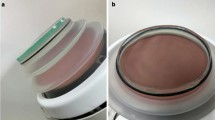Abstract
Previous in vitro studies of acoustic coupling in shock wave lithotripsy (SWL) have shown that air pockets trapped at the surface of the treatment head significantly reduce transmission of shock wave (SW) energy to the focal zone of the lithotripter, reducing the effectiveness of stone breakage. Since there are no reliable means to monitor the quality of coupling during SWL, we looked for a practical protocol to improve how coupling is achieved. In vitro studies were performed using a Dornier DoLi-50 lithotripter. LithoClearTM gel was used to couple the treatment head to the acoustic window of a clear acrylic test tank. Numerous methods of applying gel were tested including common sense variations of routine protocols typically used with patients. For each method the coverage of air pockets (% defects) was determined using digital imaging. Different coupling regimes were tested for effect on the breakage of gypsum model stones. The quality of acoustic coupling was affected by how the gel was handled—how it was dispensed and applied, and whether the gel was applied only to the treatment head or to both the lithotripter water cushion and the test tank (surrogate patient). Dispensing gel from a squeeze bottle for application by hand created significantly more defects than when a large volume (∼250 ml) of gel from the stock jug was applied as a mound to just the treatment head (26.5 ± 2.7 vs. 1.2 ± 0.5% defects, P < 0.001). The efficiency of stone breakage was better when gel was applied from the stock jug compared to application by hand (P < 0.006). Poor coupling was substantially improved by using the inflation feature of the water cushion to collapse air pockets, but this strategy was not a substitute for establishing good coupling at the outset. The quality of coupling in shock wave lithotripsy can be improved by minimizing the handling of the coupling medium. Hand application of coupling gel is clearly not the best way to prepare for lithotripsy. Better results can be obtained by delivering lithotripsy gel as a bolus to the treatment head alone, and allowing it to spread upon contact between the treatment head and the skin. These in vitro tests also suggest that the inflation feature of the lithotripter may be useful in reducing defects in coupling.




Similar content being viewed by others
References
Chan SL, Stothers L, Rowley A, Perler Z, Taylor W, Sullivan LD (1995) A prospective trial comparing the efficacy and complications of the modified Dornier HM3 and MFL 5000 lithotripters for solitary renal calculi. J Urol 153:1794–1797
Graber SF, Danuser H, Hochreiter WW, Studer UE (2003) A prospective randomized trial comparing 2 lithotriptors for stone disintegration and induced renal trauma. J Urol 169:54–57
Portis AJ, Yan Y, Pattaras JG, Andreoni C, Moore R, Clayman RV (2003) Matched pair analysis of shock wave lithotripsy effectiveness for comparison of lithotriptors. J Urol 169:58–62
Gerber R, Studer UE, Danuser H (2005) Is newer always better? A comparative study of 3 lithotriptor generations. J Urol 173:2013–2016
Cleveland RO, McAteer JA (2007) The physics of shock wave lithotripsy. In: Smith AD, Badlani GH, Bagley DH, Clayman RV, Docimo SG, Jordan GH, Kavoussi LR, Lee BR, Lingeman JE, Preminger GM, Segura JW (eds) Smith’s textbook on endourology. BC Decker, Inc, Hamilton, pp 317–332
Pishchalnikov YA, Neucks JS, VonDerHaar RJ, Pishchalnikova IV, Williams JC, McAteer JA (2006) Air pockets trapped during routine coupling in dry-head lithotripsy can significantly reduce the delivery of shock wave energy. J Urol 176:2706–2710
Pishchalnikov YA, Beard S, Pishchalnikova IV, Williams JC Jr, McAteer JA (2006) Bubbles trapped at the coupling surface of the treatment head significantly reduce acoustic energy delivered in shock wave lithotripsy. In: 5th Int’l Symp Therapeutic Ultrasound, AIP Conf Proc, vol 829, pp 643–647
Pishchalnikov YA, McAteer JA, Neucks JS, Pishchalnikova IV, Williams JC Jr. The problem of coupling in dry-head lithotripsy. In: Evan AP, Lingeman JE, Williams JC, (eds) Renal stone disease: proceedings of the first international urolithiasis research symposium. American Institute of Physics, Melville, pp 368–371
Jain A, Shah TK (2007) Effect of air bubbles in the coupling medium on efficiency of extracorporeal shock wave lithotripsy. Eur Urol 51:1680–1687
McAteer JA, Williams JC Jr, Cleveland RO, Van Cauwelaert J, Bailey MR, Lifshitz DA, Evan AP (2005) Ultracal-30 gypsum artificial stones for research on the mechanisms of stone breakage in shock wave lithotripsy. Urol Res 33:429–434
Pishchalnikov YA, Sapozhnikov OA, Bailey MR, Pishchalnikova IV, Williams JC Jr, McAteer JA (2005) Cavitation selectively reduces the negative-pressure phase of lithotripter shock waves. Acoust Res Let Online 6:280–286
Acknowledgments
This project was supported by NIH grant DK43881.
Author information
Authors and Affiliations
Corresponding author
Rights and permissions
About this article
Cite this article
Neucks, J.S., Pishchalnikov, Y.A., Zancanaro, A.J. et al. Improved acoustic coupling for shock wave lithotripsy. Urol Res 36, 61–66 (2008). https://doi.org/10.1007/s00240-007-0128-y
Received:
Accepted:
Published:
Issue Date:
DOI: https://doi.org/10.1007/s00240-007-0128-y




